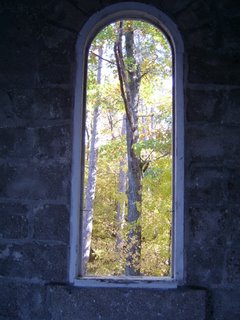Endings or Beginnings?

It occured to me while I was out on the trail today that, while some people see the fall as the end of something, for others of us it is the beginning of something even more powerful. While the colors signal the fact that summer has come to an end and winter is approaching, the falling leaves also are necessary to provide the nutrients for the next season's flora.
I think the reason this was so pronounced for me today is that I encountered two different types of folk out on the trail from different ends of the life-cycle. The first were several senior citizens, some paired off, slowly making their way, judiciously navigating protruding tree roots, all the while smiling at the surprising warmth of the day. Ahead of me at one point there was an older couple, holding weathered hands, just shuffling along. At another point, I heard the rhythmic thud-thud of feet pounding into the dirt headed directly for me. Suddenly, there burst through the trees young adoloscents from the Prep School out for an afternoon run. Some were giggling, others talking, others oblivious to what was going on around them (ear buds blanking out the natural sounds of life for some artificial blast from an IPOD). But both types were framed ahead and behind me by the canopy of overarching leaves suggesting, on the one hand, the dying of the light, on the other, new beginnings.
The picture above was taken inside a now disused chapel (Stella Maris) which has a lone stone table inside (think Lewis' The Lion, the Witch, and the Wardrobe!). On either side are three open chapel windows which served as a frame for what stood outside. Did the chapel represent the death of something or the possibility for a different kind of life just outside the ordinary? These juxtapositions are familiar referents for me as I continue to read through the literature from the English Reformation. For some, like Eamon Duffy, the reforms meant the death of something quite dear (late Medieval piety). For others, like A. G. Dickens, it signalled the fresh winds of Renaissance learning and the gospel cry of Martin Luther's "sola fidei."
Allen M. Young, a curator of zoology at the Milwaukee Public Museum, speaks of this conundrum in the natural world in his book, Small Creatures and Ordinary Places, in this way:
"Consider thinking of this cycle of seasons in the following way. In spring, life sprouts from the eggs and seeds sown last summer, well before the first frost and autumn's descent over the land. In summer, life reaches a full bloom, not just among plants but among animals too. Then in autumn, life literally falls off its pedestal of prolific glory. But while autumn may feel and behave as an ending, it is really a new beginning. For all that we enjoyed in the yard or meadow this summer has its living fate now sealed away beneath the leaf mulch, in the soil below the frost line, even in the middle of rotting logs in the forest. Life has gone underground only to be saved from winter's wrath and to bloom once again to great heights next summer. In autumn, the drama of life switches for most creatures from branches, leaves, and stems to the mulch below, and in winter to the deep recesses of pond-bottom mud and sand. Life flourishes but it is temporarily more subdued than exuberant."
--From Schmidt and Felch, Autumn: A Spiritual Biography of the Season, 48.


<< Home